
The future of mobile working has arrived. Step into my virtual office.
In the heart of Silicon Valley, you can slip on a virtual reality headset and fly through a photo realistic 3D representation of what will soon become chip maker Nvidia’s new headquarters.
The $380 million building will eventually house over 2,500 employees and is due to open in late 2017 but what’s most impressive about the building is not just the way in which it as designed – using Virtual Reality but the fact that it will be the world’s first building that has a mirror image in both the physical and virtual worlds. And that’s not by coincidence.
This will be the first building where people using VR headsets at home can “mingle” with their colleagues who are sat in the office – VR seamlessly blended with artefacts and individuals in the real world. Use VR to “walk” into a conference room, for example on the second floor and you’ll be able to instantly collaborate with the other people who are actually sitting in that room. The future of the workplace might have just arrived – albeit that it will take years, if not decades for other companies to adopt a similar approach. The ultimate in mobile working.
Powered, as you’d expect, by Nvidia technologies the building was architected by design firm Gensler from start to finish using VR headsets from HTC, Nvidia’s new, highly interactive rendering software Iray which made it possible to quickly alter everything in the company’s architectural design simulation and 15 of the company’s cloud based Quadro Visual Computing Appliances (VCA). From the location, size and transparency of triangle shaped skylights to material surfaces and colours nothing was left to chance.
For the first time this combination of technologies let the architects create photo realistic renders so intricate that they could simulate dust travelling through beams of sunlight so they could get a better understanding of what the building would look and feel like in real life.
“We have never been able to capture the fidelity we are able to reach today,” said Jen-Hsun Huang, co-founder and Chief Executive of Nvidia, “The rug has to be precisely like the rug in the real world and the paint has to be the paint.
“We created the world’s largest simulator of photons, the teams rendered every light beam for every hour of the day for every day of the year.”
The office itself, as you might imagine is high tech, fully wireless and completely reconfigurable, and in keeping with Nvidia’s flat management style there will be no discernable executive suites.
“I was pretty much like a kid in the candy store when they first gave me access to a cluster of processors running Iray,” said Scott DeWoody, a visualization artist for Gensler who has worked on the project. “I stayed up until three in the morning.”
If the new office is as big a hit with Nvidia’s staff as it is with the designers then it might also be the blueprint for the way we all work in the future and if that means being able to “work” from the beach then I for one applaud it!
















